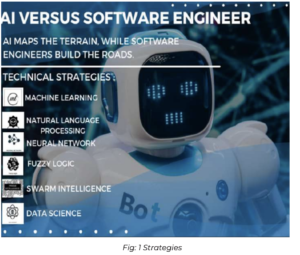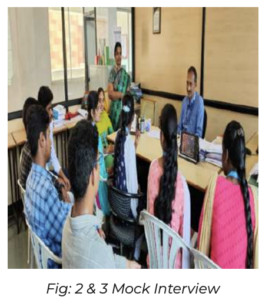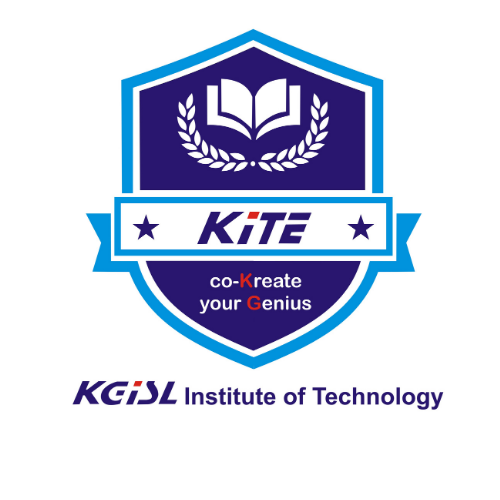Research Objectives:
The aim of this research study is to examine the differences and intersections between AI, ML, and CI, highlighting their roles in technological advancements. It also seeks to guide students in understanding and applying these fields to develop intelligent systems.
Keywords:
artificial intelligence; software; dichotomy; computational intelligence; metamorphosing
Bio
Dr. P. Prabhavathy is currently serving as an Associate Professor of English in the Department of Science and Humanities, KGiSL. She has authored technical textbooks, workbooks, reference books and contributed to articles, chapters, research papers etc., for publication in the international conferences, Journals, Magazines etc., She is a speaking cum Written Examiner of BULATS – ESOL Examinations, British Council, Cambridge Assessment and Evaluation, EBEK. Dr. Prabhavathy has been honoured with many awards and recently recognised as an AICTE certified UHV Mentor.
Abstract
Artificial Intelligence and Machine Learning are two emphasising branches of computer science, authorities have acknowledged their discrepancy and the roles that they both offer in advancement of computer applications. Both fields have upended industries, reasserting the way we interact with technology and metamorphosing how business operates. In the convoluted domain of technology, the juxtaposition between Artificial Intelligence and Software Engineering emerges as a perpetual enigma, akin to untangling a Gordian knot. This discourse endeavours to delve into the intricacies of this dichotomy, peeling back the layers that differentiate these two formidable domains. Computational Intelligence is the design, theory, application and linguistically motivated computational framework. CI act a major role in building a successful intelligent system, games and cognitive development of system in this regard mock interview guides the students of Engineering and Technology to kickstart with trends and application of Machine Learning (ML), Natural Language Processing (NLP) and Computational Intelligence (CI).
Introduction
The dichotomy between AI and Software Engineering manifests in their divergent methodologies and objectives. While AI strives to imbue machines with human-like cognitive prowess, Software Engineering is focused on crafting robust, efficient software solutions. The fusion of AI-driven algorithms with software engineering principles yields groundbreaking applications, from autonomous systems to intelligent virtual assistants. AI are booming although in certain Industries are started to appoint AI in a position of software Engineer and also in the post of Human Resource (HR). Nowadays, the question frequently raised is do AI replace human? To answer this question, we need to know about efficiency of AI and software Engineer. Design and creativity thinking are the fundamental skill of IT professionals as increasing these steps generative AI and low code take a great space on coding load like speech recognition. The primary goal of the students pursuing professional courses is to learn the technical aspects of their respective professions. Its fundamental essence lies in mirroring human cognitive faculties, traversing the labyrinthine terrain of intricate decision-making and pattern recognition. As we navigate this intricate web of algorithms and heuristics, we encounter the words of Alan Turing echoing through the corridors of innovation, “We can only see a short distance ahead, but we can see plenty there that needs to be done,” encapsulating the perpetual quest of AI to transcend the boundaries of artificial intelligence. On the other hand, software engineers are in the process of upgrading themselves. It adheres to structured methodologies such as Agile or Waterfall, emphasising precision, reliability, and scalability.
1.1 A Confluence of Changes and Beneficiary of Machine Learning and Natural Language Processing
The words of Frederick P. Brooks Jr. reverberate in this realm, “The programmer, like the poet, works only slightly removed from pure thought-stuff,” elucidating the creative yet disciplined approach inherent in software engineering. AI has developed in the recent years as an emerging career towards students. Nowadays, everything is handled by machine. By introducing machine learning algorithms, we can design the model to our requirements. Modern times building a robot (AI) becomes facile, as it is used in every field all over the society. It also provides us with the evolution of skills that are in high demand. The roles and responsibilities towards the career path are expected to be superior. Nevertheless, as the software engineering society observes the escalate need for AI talent. Software engineers aspire to move their profession towards AI. Undoubtedly, both Software Engineers and AI will continue to be in leading demand. As software Engineers are required to innovate new techniques and methodology in the technical world. The point of divergence is the converging and differing skill sets between AI and software Engineers.
AI has the competence to create and manage the development, creation of automation and also do statistical analysis. It is well developed to provide the organisations decision making spirit. By training the AI model it also helps the manager and stockholders in the analysis process. We can also introduce the Machine Learning models into programming, and it can be integrated with our application. Computational intelligence has the key component known as fuzzy logic, they handle with the checking process of value whether it is true or false. Fuzzy logic allows the user to represent the concept of fuzzy by allowing the system to make decisions based on the given instructions.
Accessibility of fuzzy logic involves defining the fuzzy sets, fuzzy rules to undoubtedly get into real world problems. Evolutionary computation within CI have inspired biological evolution and natural selection. The working of evolutionary algorithms involves creating a solution over mutation, fitness, genetic crossovers. It is effective in finding solutions to given tasks. At its core, CI works on various computational models and approaches to solve complex problems based on the algorithms. The fundamental feature of CI is neural network. They are mathematical models inspired by structures and functions of neural networks, interconnected by nodes and arranged in layers. The working of neural network involves in strengthening between connections and nodes from the input. Swarm intelligence is another fascinating field within CI, where it collects the activity of social insects such as bees, ants. There are two optimisations, namely ant colony optimisation and particle swarm optimisation. The working of swarm intelligence involves in interacting generally with their environment to provide the optimal solution towards the problems. There are plenty of methodologies available to create intelligence in taking decisions and solving the problem by self-organized process. These are the key methodologies used in CI while working on the projects. CI is also efficient in finding fraud detection, moreover in robotics and autonomous systems. It has numerous advantages especially in areas such as hiring, lending, and law enforcement. CI techniques such as machine learning algorithms have empowered business and research to follow the valuable data by optimisation process to create innovative solutions. Some of the drawbacks are seen in CI is risk of reliance, where humans trust the AI without an evaluation of themselves. This case will lead to errors in the program, the development and maintenance of CI needs to be expertise in the data science domain. Although they ensure the transparency and accountability of the system.
1.2 Decoding the Dichotomy: AI vs. Software Engineer
Software Engineering is in top demand in industry from the survey of past few years. Most of the MNC’s are welcoming and offering a job role for software engineers, they also provide internship for new graduates and students. The action taken by these companies is greatly beneficial for students to work in Hands-on projects and to develop their skill accordingly to their interests. Software architecture is acknowledged as a different expertise Category from software design. The roles of software Engineer are to test and compose software application to evaluate the requirements, estimate the cost of deployment and to implement the system software. They also review the project that they build with peers and stack holders to decide the current tools. software Engineers are highly skilled, they can do the necessary outcome that is expected from the industry. A distinct opportunity is over the software engineers. The society of software Engineers must adopt a realistic approach, avoiding the temptation to transform all software Engineering programs into AIfocused ones.
Let us focus on the key features where AI focuses on building artificial intelligent systems that can perform human tasks. AI software includes natural processing, machine learning, deep learning, and computer vision of the system. Software Engineers focus on consistent, efficient and adaptable software solutions using programming languages, deployment and building model methodologies and frameworks. AI uncovers the applications in diverse domains like finance, Hospitals and health care, driverless vehicles and support services. Most of the AI system are build using the principle of software engineers by Integrating AI techniques into their solutions. AI sets up the system and tools to make decisions under precise standards. AI is generally trained during the time habitual beyond supervision.
On the contrary of AI replacing the software Engineer, deployment of machine learning algorithms skilled by software Engineers will provide the outcome of software Engineer performance by intensifying required practices. Let me give a live example that has already been on board, Cognition is a steering company where they have built the world’s first AI software engineer called DEVIN that can do any technical work assigned to it. As a virtual software engineer it is well known for the accuracy of the outcome with or without an assistance, they have the ability to code and operate the code, plans, design and finally they can also deploy software projects.
Devika, Indian AI engineer manifests to hurdle Devin. Devika AI was spearheaded by Mufeed VH of Lyminal and station, where it aims to compete the efficiency of Devin the AI coder. Similarities of Devin are introduced in Devika such factors are power of machine learning and natural language processing by understanding the human instructions. In spite of that Devika district itself deconstructed these institutions into actionable tasks. Here Devin’s accessibility and features remains obscured in mystery, Devika’s functionality is transparent as they are open-source nature of evolution.
The key feature of Devika is that the model is trained in a way to interact in a feedback loop, explore, decision making, research accordingly, coding a program, it also answers to the queries raised by users to archive the project outcome. It is capable of rectifying the error generated from the code autonomously without the involvement of user as a motive to minimise the human power. Devika has also created static websites on Netlify. As it is a python – based project any user needs to install the latest version of python to their system, if they need to work with Devika.

While coming for the benefits of using Devika AI over Devin AI, it has increased productivity as they focus on more complex aspects of software development for faster completion of the project before the deadline submission. It is also beneficial as they are reducing errors spontaneously without the need of the human. Devika breaks down the assigned tasks and works on them to improve the learning curve structures. Finally, accessibility and collaboration make Devika contribute its development and practice towards the outcome.
The fact about the virtual software engineer they can solve the problem in well skilled manner by providing the efficient result. The founder of Devin states that they will not replace software engineers, instead they are freeing up the developer for higher level thinking and creative solutions for the problems. However, navigating this dichotomy is not without its challenges. Ethical quandaries surrounding AI’s decision-making capabilities and the imperative for stringent software engineering practices underscore the need for a harmonious convergence of these domains.
The collaboration between both the fields will bridges the dichotomy by leveraging the strength of each discipline with intelligence functionalities. Even though there are plenty of innovations emerging in AI technology, they cannot be as accurate as humans. Trusting AI will obviously not advisable as they make faults often, humans need at least to monitor the work of the AI. The duty of humans is still in demand in all fields to check over and to operate AI in wise way. The necessity of prompt engineers is at peak to deal with these machines. Prompt engineers play a crucial role in designing the behaviour and capabilities of AI models, ensuring that they produce accurate and relevant results.
While examining the job crisis between AI versus software Engineer, it is crucial to consider the sophisticated interplay in the evolving technologies. AI, with its advancement in technique has undoubtedly disrupted traditional job roles across various industries. AI on phrase has introduced new job opportunities particularly in certain domains of its major such as data science, AI research and warehousing. The work done in the industry is now handled by AI, resulting in job losses in many sectors such as manufacturing, customer service role.
2. Mock Interview
There are more and more chances for engineers and technical professionals to convey technical information in English for various purposes. The primary goal of the students pursuing professional courses is to learn the technical aspects of their respective professions. Similarly, the practical suggestions for developing language skills in the learners and each item followed by tasks that the students motivated to do on their own. Teaching aids prove effective only when it suits the teaching objectives and group of learners. The aid should be displayed properly so that all the students are able to see it, observe it and derive maximum benefit out of it. English for Academic Purposes (EAP) entails training students, usually in a higher education setting, to use language appropriately for study. It is a challenging and multifaceted area within the wider field of English Language Teaching (ELT) and is one of the most common forms of English for Specific Purposes (ESP). English for Academic Purposes programme focuses instruction on skills required to perform well in an Englishspeaking academic context English for Specific Purpose (ESP) is to meet the specific needs of the learners. It makes use of the methodology and activities of the discipline it serves, and it is purpose. It is the teachers’ responsibility to propose a variety of exercises, both written and oral, to improve the learner’s accuracy, fluency and communicative ability. At times the teachers’ should translate-if they know both languages very well and believes it is the most efficient way to provide the meaning of a new concept in that moment, especially abstract ideas and also the teachers have to correct errors immediately if the scope of the classroom activity is accuracy, but if the scope of the activity is fluency these errors will be corrected later on.
2.1 QUESTIONS WITH ACADEMICIAN(S) AND ADMINISTRATOR (S)
- Is it good to kickstart with NLTK journey?
- Few suggestions about ML, NLP and CI
- Share some credits about Text Summarisation
- Opinion about Language Modelling Module
- Do you find Masked Language Model really aids Software Engineers and others? If so… How?
- Whether the text corpus in NLP enrich language skills?
- Your appreciation with regards to paper cum paperless work
- Do you agree with the title decoding the dichotomy AI versus Software Engineers?
- Share some unique features about Devin’s and Devika’s AI
- About Quantum computing and its sustainability

Language learning is done best in a non–threatening atmosphere. Learner errors are dealt through self–monitoring and peer correction. Through understanding the teachers, it can help the students to overcome their fears and work more positively towards learning a new language. Remedial teaching is different from the other kind of teaching in the sense it has only one main purpose that of correction of errors. Language games and communicative activities help a lot to learn the language interestingly. Pair work and group work should be encouraged where the students get opportunities to interact with their pairs without fear. Language lab helps the students to remedy the errors in pronunciation. These are the some of the remedies where the students could feel free in learning the language without fear and inhibitions.
The teachers have to develop all four linguistic capabilities (reading, writing, listening and speaking). The role of teacher at first is to identify and find out the needs of the individual learners. Then, the teacher has to find out effective strategies to be implemented to provide an active, interesting and interactive process of learning for the students with different levels of ability. Focusing on both intellectual and social goals, the teacher should figure out stages, roles, and problem-solving strategies that support student competence. Teachers should feel responsible for teaching; shaping; moulding; and motivating the students to learn English language. If English language teachers can make students feel successful and not give up their efforts in acquiring skills, there lies the success of teaching. The teacher’s responsibility is help to students to develop the skill in written.
Conclusion
To conclude, the mock interview with regard to Computational Intelligence is an activity conducted among Engineering & Technological students with higher officials as a practical teaching aid to create awareness and gain knowledge about the classifications of AI. The contrast between AI and Software Engineering reflects a dynamic blend of innovation and discipline, creativity, and precision. As we makeover through this intricate landscape, a holistic understanding of their overlaps and distinctions becomes crucial, mirroring the essence of Leonardo da Vinci’s saying, “Simplicity is the highest form of sophistication.” In addressing the scarcity, software Engineering is not limited to the industry but rather has applications and demand in multiple fields, by providing a wide range of options. To effectively navigate the job crisis AI and software engineering realms, individual and organisations must prioritise continuous learning and developing the necessary latest skills and to be updated about each and every newly emerging technology, is essential for maintaining relevance and adaptability in a rapidly changing professional environment.
References
IEEE – Author: Ipek Ozkaya with reference to S. Overmyer, Jobs of the future: Emerging trends in artificial intelligence, Aug. 2022, [online] Available: https:// www.indeed.com/lead/ artificial-intelligence-report
WEBSITE – Dzone: AI and software engineer differences Available: mp;url=https:// dzone.com/articles/Artificialintelligence-vs-Softwareengineering%23
NDTU: Indian AI Engineer Devika Emerges to challenge Devi, The World First ‘AI Coder’. Available: https://www. ndtv.com/feature/artificialintelligence-indian-aiengineer-devika-emerges-tochallenge-devin-the-worldsfirst-ai-coder-5355983
Cognition: Introducing Devin, the first AI Software Engineer. Available: https:// www.cognition-labs.com/ introducing-devin



